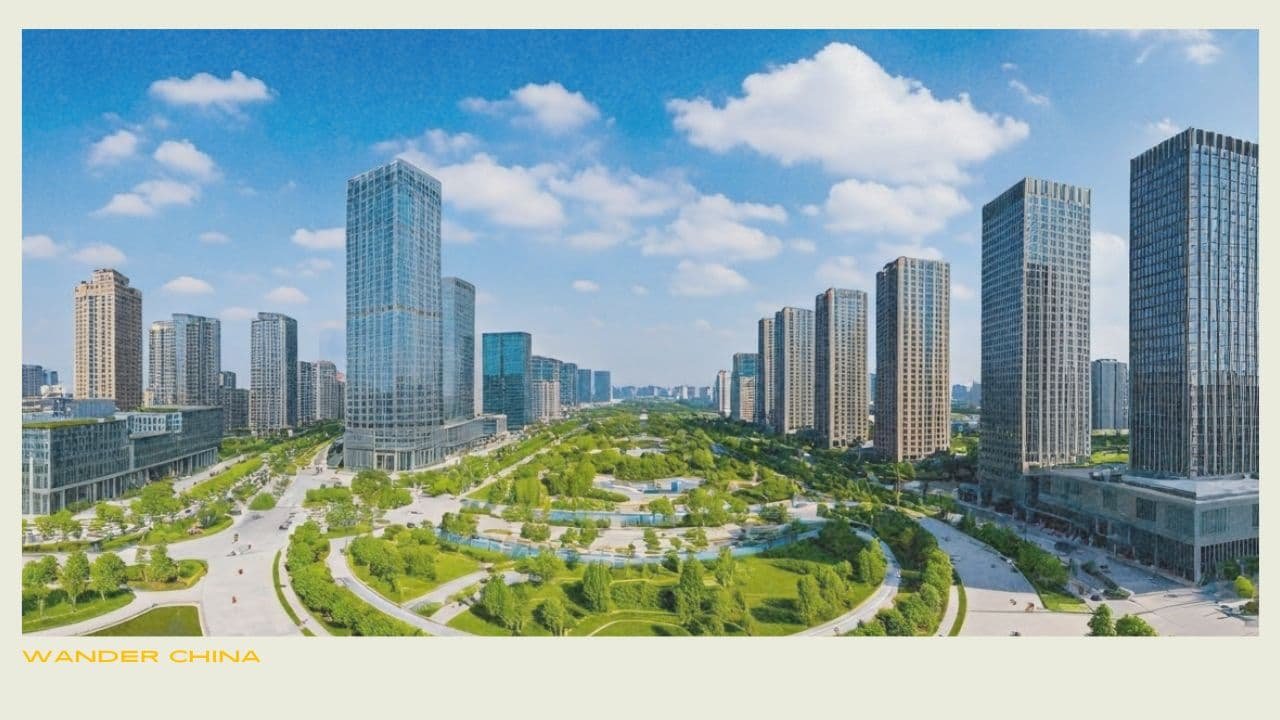Quality of Life in China: A Comprehensive Overview
Discover the quality of life in China with our comprehensive overview. Explore insights on living standards, healthcare, and more.

Key Highlights
- China’s fast economic growth has made life better for many people, especially in cities. We see this through longer life expectancy and better access to modern things.
- Despite these changes, income inequality still exists between urban and rural residents. This makes it hard for them to get healthcare, education, and social security. We need better policies to fix this issue.
- The Chinese government works to protect the environment. They tackle pollution by enforcing stricter rules, encouraging renewable energy, and planning cities with more green spaces.
- Access to healthcare has improved, but there are still problems in providing enough mental health services and support for older people.
- Quality of life can change a lot between areas. Coastal cities usually offer better living conditions than inland provinces.
This blog post is about the quality of life in China. It looks at how economic growth and social development are linked. We will examine different aspects that impact people’s happiness in China, including the driving factors that contribute to this.
We will discuss the good changes as well as the challenges they still experience. Important factors include healthcare, education, income distribution, and the environment. Our goal is to help you understand what influences the lives of people in China today.
Exploring the Dimensions of Quality of Life in China
Assessing quality of life is not easy. We have to think about many things, not just money. GDP growth and income give us some information, but we also need to check other factors. Future research into these factors affects how people live daily and how happy they feel.
Factors such as good healthcare, education, social security, environmental quality, and cultural opportunities are very important. They all link together and impact a person’s quality of life. By looking at these factors, we can learn more about what life is like for people in China.
Defining Quality of Life: A Multifaceted Approach
Quality of life assessment looks at more than just money. It also checks personal happiness, health status, and health utility values, as well as the chances people have in life. This shows that how people feel about their lives is very important for seeing how well society is doing.
A thorough analysis should look at key facts such as life expectancy, literacy rates, and income. It should also consider how happy and satisfied people feel with their lives.
By looking at both facts and feelings, we can learn what makes a good life for the Chinese population.
Historical Evolution and Current State
Mainland China has grown a lot in its economy over the past few years. It has moved from mostly farming to playing a big role in the global economy. This economic growth has improved the quality of life for many people.
More people can access education, healthcare, and modern facilities now. This is especially true in urban areas. However, we still have some challenges to face.
Income inequality, harm to the environment, and differences between regions are still major issues. We should pay attention to social development and economic growth. By focusing on both, we can make the quality of life better for everyone.
Economic Growth and Its Impact on Quality of Life
China’s economic growth has really helped many people. It has lifted millions out of poverty. This growth has also changed how the world views the country. New cities are built, technology is moving forward, and people can get more products easily. Because of this, life and living conditions have improved quite a bit for many.
Not everyone gets to enjoy this growth. There is a big gap in income. This is especially clear when we look at people living in cities and those in rural areas. Income inequality is a big issue. It makes it hard to ensure that everyone can have a better quality of life.
GDP Growth and Per Capita Income Trends
China’s economy has grown a lot. For years, its GDP has been rising steadily. China is now the second-largest economy in the world. This growth has raised the average income of its people. It has helped many people escape poverty and improved the national average as well.
Income inequality is a serious problem. Cities are expanding quickly. People who live in cities usually make more money. On the other hand, rural areas face a lot of challenges. They struggle with lower pay and have fewer job options.
The big gap in income affects the quality of life. It makes it hard for people in those areas to access healthcare and education. Many feel unhealthy. It is crucial to close this gap. If we do, everyone can benefit from economic development in China.
Employment Rates and Job Security
Employment status is important for a person’s quality of life and is often associated with better socioeconomic status. It impacts their income, feelings of safety, and how others see them. In China, many folks in urban areas feel anxious about job security. A lot of people are trying hard to get good jobs there.
Employment rates are steady at this time. However, changes in the economy from automation and new technology bring both new chances and challenges. The gig economy is expanding. It includes short-term jobs and freelance work. This kind of work provides flexibility. But, it usually does not have the security and benefits that regular jobs offer.
It is important to respond to changes in the job market. A good reaction can make workers feel safe and valued. When workers feel this way, their quality of life can improve.
The Role of Technology and Innovation
Technological changes are quickly changing China’s economy. These changes impact how resources are used and how people can work effectively. They also change what work means. These shifts can greatly affect the quality of life. They create new chances, but they also come with some challenges.
- Better Access to Services: Technology helps people easily find information, healthcare, education, and more, especially in cities. Online shopping sites allow rural residents to find more products and access different markets.
- More Efficiency and Convenience: Digital payment systems, fast internet, and smart city programs make daily life easier for everyone.
- Job Loss and Skills Gap: Automation and AI can increase productivity. However, they also raise concerns about job loss and create a need for new skills.
It is crucial to keep up with quick changes in technology. We need to make sure that everyone can take advantage of new ideas. This will help to boost the quality of life for everyone.
Health and Healthcare System Efficacy
China has made big improvements in health in recent years. People are living longer and fewer babies are dying. The government has invested a lot of money in public health. They have worked hard to enhance health care services, especially in rural areas.
We still need to solve some problems. A lot of people live with chronic diseases. Many cannot get good health care, especially in rural areas. This is different from what people in cities experience. Mental health issues are also serious in the current study context. Many see these problems in a negative way. Because of this, they do not get the help they need.
Public Health Initiatives and Outcomes
Public health programs by the Chinese government have made health much better. They often work with groups like the World Health Organization. Their work includes vaccination drives, better sanitation, and monitoring diseases. These efforts have helped people live longer.
One big goal is to make health services easy to use. This is really important in rural areas and places that do not get enough help. We are now opening clinics in villages. We are also using barefoot doctors. This way, basic care can reach these remote areas.
Keeping these services good and affordable is still hard. The rising costs of healthcare can be a huge issue for many people. This is especially true for special treatments and long-term care that are needed for illnesses.
Access to Healthcare Services and Insurance
Access to good and affordable health care matters for social welfare in China. The government is working hard to provide health surveys and health insurance to more people. This support helps them avoid large medical bills.
People living in cities are different from those in the country. There are also differences in income among groups. Vulnerable populations, such as migrant workers and older people, often have a hard time getting health care when they need it, as highlighted by health services surveys. This is due to problems like residency permits and not having enough support for their health problems.
It is important to solve these problems. We need to ensure that all citizens can access basic health care services. This should apply to everyone, no matter where they live or how much money they have. If we do not take action, it will be hard to get fair health outcomes for all.
Chronic Diseases and Mental Health Concerns
As people in China get older and their lifestyles change, many face long-term health problems. Common issues include heart disease, strokes, cancer, and diabetes. These health problems put a lot of stress on the healthcare system. They also lower the quality of life for individuals and their families.
Mental health problems are growing more common. Many people do not talk about these issues, especially in urban areas. Issues like depression, anxiety, and stress happen more often now. This shows we need to spread awareness and make it easier to get help. Changing how society views mental health is also important.
China needs to pay attention to both physical health and mental health. This is key for raising the quality of life for all its people.
Education and Learning Opportunities
Education is very important in China. People see it as a way to move up in society. It also helps the country grow. China has worked hard to make education available to more people. This includes all levels, from primary school to higher education. Because of this, more people can read and write.
There is still a gap in education quality between urban and rural areas. It is difficult to make sure everyone gets a good education. This problem affects people, regardless of their financial situation.
Literacy Rates and Educational Reforms
China has a high literacy rate. This shows that the country cares about giving everyone a basic education. Recently, changes have been made in education. These changes aim to improve teaching quality in rural areas. They also want to provide equal opportunities for all students.
Kids from low-income families or those who live far away still face problems. They often find it hard to get a good education. This makes it harder for them to do well later. The education level people reach has a strong impact on their job choices, income, and quality of life.
- It is important to close the gaps in education.
- We need to put money into training teachers, improving lessons, and fixing schools, especially in areas that need help.
- These steps will help kids succeed and achieve their full potential.
Higher Education Accessibility and International Collaboration
China has invested a lot of money to make higher education easier to reach. This supports the economy and allows people to grow. Many new universities and colleges have started. They offer more choices for studying and research.
Today, countries are working together. Chinese universities are teaming up with schools all over the globe. This helps them share knowledge and connect students from different nations. Still, there are some problems that need fixing. We must make sure that higher education is fair for everyone.
High tuition and living costs are hard for students. This is especially true for those from low-income families in rural areas. Financial aid and scholarships are important to help with these issues. They assist students and make higher education easier to reach for everyone.
Vocational Training and Lifelong Learning
The way we work is changing fast due to new technology. This means vocational training and lifelong learning are very important. China knows this need well. They are working to improve their vocational education and training system. Their goal is to give people the skills they need for jobs.
Building skills helps people get ready for changes from automation. Learning options, like online courses and training programs, let people gain new skills or improve the ones they have during their work life.
China can help its workers improve by encouraging them to keep learning. They can offer easy ways for people to adapt to changes in their jobs. This support helps individuals reach their career goals. In turn, it enhances the quality of life.
Environmental Conditions and Sustainability Efforts
China’s rapid development in cities and industries has caused several issues. A major worry is the damage to the environment. This harm lowers the quality of life and life satisfaction, especially in busy cities. People are concerned about air and water pollution, deforestation, and the effects of climate change. These problems can harm public health and leave people wondering what China’s development will be like in the future.
The Chinese government is trying to fix these issues. They are focusing more on the environment and being sustainable. They are investing in renewable energy. They are also making strict rules to reduce pollution. Plus, they support green technology. These actions help China lower its effect on the environment.
Air Quality and Pollution Control Measures
Air quality in big cities in China is very important right now. Many industries and urban areas are growing fast. This growth is making air pollution worse in several spots. It is hurting people’s health and reducing their quality of life.
To solve this issue, the Chinese government set firm rules to reduce pollution. They shut down many factories that damage the environment. They encourage using cleaner methods to create products and invest in renewable energy. This reduces the need for coal power. Now, they manage car emissions better. There are also incentives for people who purchase electric cars.
These actions may be tough, but they are very important. They help to clear the air and keep people in China healthy and happy.
Water Safety and Urban Green Spaces
Making sure that water is safe is crucial for public health and our quality of life. Water pollution is a serious problem in China. It comes from factory waste, runoff from farms, and poor handling of wastewater. These issues can harm people’s health and hurt the environment.
- To help the earth, China is making stronger rules about waste from factories.
- They are also promoting better farming ways to lessen runoff.
- Moreover, they are trying to improve water treatment systems.
- It is important to create green spaces in cities for a healthier environment.
Parks, gardens, and green roofs help cities look nice. They cool down urban areas and clean the air we breathe. These places also provide spots for people to relax. All these benefits improve city life.
Renewable Energy Adoption and Conservation Policies
Transitioning to cleaner energy is key to fighting climate change and protecting the environment. China is at the forefront of this change. They are putting a lot of money into renewable energy projects. This includes solar, wind, and hydropower.
Conservation policies are made to cut down energy use and make things work better. These steps include setting energy rules for buildings and appliances. They also encourage the use of public transport. A key part of this is showing people why saving energy is important.
China can make the environment better by using clean energy and encouraging good habits. This change will create a healthier place for its people to live.
Social Welfare and Security Systems
China has an important job ahead. It needs to set up a strong safety net for its large population. This means making sure everyone gets healthcare, pensions, unemployment benefits, and help from social aid programs. These programs are really important because they help people who need support.
As China moves to a market-based economy, it is important to improve its social security system. A better system can help reduce income inequality. It will support people who are in need and keep social stability by lowering economic risks.
Pension Schemes and Retirement Benefits
As people in China grow older, having strong pension plans and retirement benefits is important. These plans should help support social welfare. The old system mostly depended on state-owned companies and farms. This system is struggling to adapt to the changes in the population and job market.
We need to make the pension system better. This change will help it last longer. It will also support migrant workers and those with jobs that are not steady. We should create a balance between what people pay and what the government gives. New ideas, like personal retirement accounts, can give better benefits for retirement.
It is important for China to create a safe and respectful place for older people to retire. This will help make society stable. It will also keep senior citizens safe.
Social Insurance and Assistance Programs
China has a social security system that supports its people with several insurance and assistance programs. These programs help with unemployment insurance, work injury insurance, and aid for low-income families and individuals who need help.
The quality of these programs can vary greatly between cities and rural areas. It is important for everyone to have equal access to social insurance. This access should not depend on anyone’s job or where they live. When people have the same access, it can reduce risks and help make society fairer.
To help lessen poverty and assist those who need it, we should increase social support programs. These programs should aim at people who need help the most. They should give quick and sufficient support.
Addressing Poverty and Inequality
China has experienced great economic growth and lowered poverty levels since the late 1970s. Yet, it still struggles with poverty and income inequality. A lot of people do not live in extreme poverty anymore, but relative poverty is still a problem. There are also big income gaps between urban areas and rural areas.
To tackle these problems, they can:
- Promote Economic Growth: Make more jobs for low-skilled workers in rural areas.
- Support Social Safety Nets: Enhance social insurance and assistance programs. Make housing easier to afford.
- Invest in People: Give good education and job training to help people improve their skills and find better jobs.
- Share Wealth Fairly: Create policies that distribute resources fairly.
By using these plans, China can build a fairer society. This means that the gains from economic growth will be shared more equally among all people.
Cultural and Recreational Life
China has a rich and diverse culture. The arts and entertainment are full of life. You can enjoy traditional opera, practice calligraphy, go to modern art galleries, and experience nightlife. There are many ways to join in cultural activities and have a good time.
The government is working hard to protect cultural heritage sites. These sites help keep traditional arts alive and attract tourists. This effort brings visitors from both the local area and other countries.
Heritage Preservation and Cultural Festivals
China values its history a lot. It understands how vital cultural and historical places are. Many steps are being taken to protect and fix old buildings, historical sites, and ancient villages. This work will help keep these places safe for the future.
Cultural festivals matter a lot. They help keep traditions going and help the Chinese population feel connected to their identity. These events come from ancient customs and beliefs. They show us the rich culture of China. Festivals like the Lunar New Year, Dragon Boat Festival, and Mid-Autumn Festival bring people together. They also give us chances to learn more about the culture.
Caring for these important cultural sites benefits people today. It also shares China’s culture and history with future generations.
Sports, Leisure, and Tourism Development
Sports development is growing fast in China. The country is putting money into sports facilities. They want more people to try various sports. This includes serious activities and fun ones like basketball, football, badminton, and table tennis. Now, China is a strong competitor in sports globally.
- There are many fun ways to unwind.
- People enjoy shopping, eating out at restaurants, going to karaoke, and playing online games.
- The travel and tourism industry is getting bigger.
- Many tourists come from both within the country and from other places.
This increase in tourism offers many great opportunities for the economy, especially in rural areas. It helps people connect and form friendships. This can improve life for both visitors and local residents.
Media, Internet, and Digital Life Accessibility
China has experienced a major rise in internet use. This change has greatly impacted how people look for information, talk to each other, and shop, similar to findings in the Hong Kong study. The online world is now a part of everyday life. It provides both convenience and connection.
Online shopping sites have changed the way we buy things. They make it easy for people to find many products and services. Social media is also important for talking and staying in touch with friends. However, this growth online also raises worries about censorship, privacy, and fake news.
Finding a way to enjoy the internet safely can be difficult. We have to make sure that everyone can access online resources fairly.
Housing, Urban Development, and Living Conditions
China is growing fast, and its cities are changing quickly. There are lots of tall buildings and new roads in the big cities. These changes show how strong the economy is. This growth has created good jobs and chances for people. But, it has also caused some problems, like the high cost of housing and living conditions.
It is important to make housing affordable. We also need to provide good public services. Planning cities wisely is a must. This balance will help improve the quality of life for all urban residents.
Real Estate Trends and Affordable Housing Policies
Real estate trends in China show that property prices are extremely high, especially in large cities. This makes it difficult for many people to buy a home. Young people and those with lower incomes feel this problem the most.
The government has created housing policies to help people. These policies seek to reduce prices and help everyone find affordable homes. They are doing several things. This includes building public rental houses, providing money to first-time home buyers, and managing property speculation.
The success of these policies is important. They will affect the housing market. This is key for the quality of life in urban areas.
Urban Planning and Infrastructure Improvements
China is putting a lot of money into building new cities and improving infrastructure. They want to make cities nicer to live in and better for the environment. They have built new ways to travel, like high-speed trains, subways, and wide roads. These improvements help people move around more easily and save time when they travel.
They are building new parks, green areas, and safer streets. This will make life better for urban residents. The country is also investing in waste management, water treatment, and green technologies. This plan aims to lessen the harm to the environment caused by fast urban development.
There are still some problems with what we are doing. Traffic jams can be hard to deal with. It’s important that everyone can use public services fairly. We should also work to maintain the special charm and history of China’s old cities. This is key for a good quality of life.
Rural Development and Migrant Worker Issues
China’s cities have grown quickly. But rural areas have different issues and opportunities. To help these rural areas grow, the focus is on improving roads and services. There is also a strong effort to support modern farming. The goal is to create jobs in places that go beyond just farming.
Migrant workers travel from rural areas to cities to look for jobs. They play a key role in China’s economy. However, they often face challenges in getting social services. They also deal with issues related to housing and educating their children.
| Issue | Description |
|---|---|
| Hukou System | Restricts access to social services based on residency permits, disadvantaging migrant workers and their families. |
| Education for Migrant Children | Difficulties enrolling children in urban schools and accessing quality education. |
| Housing Conditions | Often living in crowded and substandard conditions due to limited affordable housing options. |
| Social Integration | Facing discrimination and social exclusion, hindering their full integration into urban life. |
It is important to deal with these problems. This will make life better for rural residents. It will also help build a fairer and kinder society.
Family, Community, and Social Connections
In today’s China, families and social connections are changing a lot. Many people are moving into cities. They are adopting new values. This change is causing families to get smaller for the general public. People are also waiting longer to get married. There are more older people than before. These trends are impacting how families live and support each other.
It is vital to stay close to family and the community during changes in society. Being close helps us feel that we are part of something. It also gives us support from others and can make us feel better overall.
Changing Family Structures and Support Systems
China’s family structures have changed a lot in recent years. More families are now living in smaller homes, just with their immediate family. They are not living together with several generations anymore. This change is happening because many people are moving to cities. There is also more ability to move around and new social values that impact how families live today.
As young people move to urban areas for work and education, they often leave to start their own homes. This means that older parents remain in rural areas. This change affects how support systems function for both the elderly and the kids.
The one-child policy is no longer active, but we can still see its effects on families today. This policy led to smaller families and fewer working people. We need to adjust our social rules to help these modern families. By doing this, we can ensure that all generations receive good care.
Community Engagement and Volunteerism
Community engagement and volunteering are very important. They help people feel like they belong. These activities unite people and enhance the quality of life in local neighborhoods. Family and neighbors play a big role in building strong community connections. However, new ways to get involved are also appearing.
Non-governmental organizations, or NGOs, are gaining recognition. They focus on social problems, help the environment, and support development in communities. These groups encourage people to join in and make a difference in their local areas.
There are still several problems that make it hard for volunteer groups to work effectively. It’s important to motivate more people to join in.
Impact of Globalization on Social Norms
China’s role in the global economy has allowed people to learn about different cultures and ways of living. This exposure has changed how we think and act in society. Globalization has helped us see trends, fashion, music, and social issues from many regions around the globe.
The sharing of culture has improved life for many people. It has allowed them to think differently and see more differences around them. However, it has also raised questions about how to keep cultural traditions, maintain identity, and preserve old values.
Finding a way to mix global ideas with China’s special culture and identity is a challenge we face in our world today.
Challenges and Future Directions
China has several big challenges as it tries to improve life for its people. The population is aging quickly. There are concerns about the environment as well. The country also needs economic growth that helps all people, not just a few.
To solve these issues, China should create new rules. These rules must help development that lasts over time. They should also promote fairness in society and look after the health of everyone in the country.
Aging Population and Demographic Shifts
The increase in older adults in China is causing several issues for the Chinese general population. There will be fewer workers and more seniors who need help and medical care. This shift will put pressure on the social security system. It also means we will need more money for eldercare services and facilities.
To support older adults, we must encourage healthy aging. It’s essential to provide them with access to affordable and good healthcare during the study period of their lives. We should also help link young people and older adults. Retirement policies might need some updates too. We need to promote active aging and create friendly spaces for seniors. This will help older adults live happy and meaningful lives.
By dealing with these challenges well, we can keep social stability. This will help economic growth. With this way, China can tackle the issues that come from an aging population.
Environmental Sustainability and Climate Change
Environmental sustainability really matters for China. Climate change leads to issues like extreme weather, rising sea levels, and fewer resources. These problems can harm economic development, public health, and the daily lives of people.
- China needs to build a low-carbon economy to decrease risks.
- This means cutting down on greenhouse gas emissions.
- It also means encouraging responsible consumption.
- Investing in renewable energy is very important.
- Using energy carefully matters too.
- We must back green technologies in different industries.
It is important to fix environmental harm. This means improving air and water pollution to keep people healthy. By using methods that support development, China can build a stronger and greener community.
Technological Advancements and Social Adaptation
Rapid changes in technology are taking place in China. Technologies like artificial intelligence, automation, and big data bring both chances and problems. These tools can boost productivity and efficiency. They can improve the quality of life in many ways. However, there are concerns. They might lead to job losses and could require changes in society.
We need to help workers learn the skills they need to succeed in a tech-driven world. We can achieve this by offering education and retraining programs. It’s also important to consider ethical issues, protect data privacy, and reduce the digital gap. This is essential for us to enjoy the advantages of technology while lowering its risks.
As technology advances, we must support social change and inclusion. This will ensure that everyone can benefit from these new developments.
Comparing with Other Countries
Comparing the quality of life in different countries can be hard. You need to think about many things like culture, economy, and society. China has improved the living standards of its people. But there are still significant differences when we look at developed countries. This is especially clear in healthcare, social welfare, and environmental protection, highlighting the changing trends in quality of life.
China is growing fast. It is also addressing its social and environmental issues. This effort can assist other countries that are also trying to change. They can learn what actions to take.
Quality of Life: China vs. United States
Comparing the quality of life in China and the United States shows several clear differences. The United States often does better in areas like GDP per capita, healthcare, and education quality. However, China has worked hard to improve living standards, especially in urban areas.
One big difference is the social safety net. The United States has a strong economy, but it does not offer universal healthcare. In contrast, China is working to improve its social insurance programs to help more people get healthcare. However, income inequality remains a major issue in both countries. This problem can limit opportunities and lower the quality of life for many people.
Cultural differences and personal choices play a big role in how people feel about their quality of life and can influence the effect sizes related to these perceptions. When we look at these two countries, it’s important to think about the different factors and signs that matter.
Lessons from European Quality of Life Models
European countries, especially in Northern and Western Europe, enjoy a high quality of life. These nations focus on social welfare and protecting the environment. They also strive to create a good balance between work and personal time. China could learn from these countries to improve its own quality of life.
Many countries in Europe have universal healthcare and strong social security systems. They also focus on the environment. They follow strict rules and spend money on renewable energy. These efforts lead to greater social equality and help people feel better overall.
China has a unique culture and specific needs. It should make its own plans. Still, China can learn from the successful ideas of other countries. By using their good ideas, it can help boost the quality of life for everyone.
Emerging Economies and Comparative Analysis
A study about the quality of life in China, India, Brazil, and Indonesia shows a need for development plans that are fair and last a long time, as indicated by various research findings available on Google Scholar. Economic growth can help people improve their lives, but by itself, it is not enough.
To help everyone feel the benefits of this growth, we need to invest in education, healthcare, roads, and safety programs. It’s also important to look at income inequality. We should support gender equality and protect the environment to ensure development for all.
Emerging economies can support each other. They can exchange helpful ideas. When they collaborate, they can address shared problems. This will help them build a better and richer future for their people.
Conclusion
In summary, the quality of life in China has many key features. These include economic growth, effective healthcare, and strong education options. The country cares for the environment and has solid social welfare systems. Also, China has a vibrant culture.
China is facing challenges and accepting new technology and social changes. It needs to deal with several important issues. These include an aging population, climate change, and the need for new ideas. How China tackles these problems will be very important for improving the quality of life for its people. By learning from other countries and focusing on development, China hopes to make living conditions better and create a peaceful society.
To understand its development and options, check different aspects of the quality of life in China.
FAQs
What are the key factors affecting quality of life in China?
Economic development
Access to good health services
Education
Support from social security
The state of the environment
How does China’s healthcare system impact its citizens’ quality of life?
China’s healthcare system is now much better. Public health programs and easier access to care are helping people feel healthier. This boost in health has resulted in a longer life expectancy. As a result, the quality of life for citizens has improved too.
What measures is China taking to improve environmental quality?
China is working hard to improve the environment.
They are reducing pollution.
They are putting money into renewable energy.
They practice conservation policies.
Lastly, they are making stronger laws to protect the environment.
How does the cost of living in China compare to other major countries?
The cost of living in China can be very different, especially when comparing it to South Korea. It depends on where you live and how you choose to live. In general, it is cheaper to live in China than in many developed countries. But in big cities, housing prices are going up. This increase affects the standard of living. Young people feel this change the most.
What are the future prospects for quality of life improvements in China?
To make our quality of life better in the future, we should pay attention to some important areas. First, we need to fix income inequality. Second, we must protect our environment. Third, we should embrace new technology. We also need to make rules that support social development and help our citizens feel safe and well, informed by Population Health Surveys.
Recent Posts
- Top Guangzhou Watch Markets to Visit in 2025: The Ultimate Insider’s Guide
- My Guide to the Best Home Appliance Markets in Guangzhou
- Guangzhou Garment Wholesale Markets: My Local Guide
- Best Hotel in Guangzhou: A Comprehensive Guide for Foreign Travelers
- Guangzhou Food Guide: Must-Try Dishes & Top Restaurants (2025 Edition)
Recent Comments
Top Guangzhou Watch Markets to Visit in 2025: The Ultimate Insider’s Guide
I visited the top watch markets in Guangzhou to show you where...
My Guide to the Best Home Appliance Markets in Guangzhou
Explore top offline home appliance markets in Guangzhou with local tips, Chinese...
Best Hotel in Guangzhou: A Comprehensive Guide for Foreign Travelers
Find the best hotels in Guangzhou—from luxury icons to local favorites. Updated...
Guangzhou Food Guide: Must-Try Dishes & Top Restaurants (2025 Edition)
I’m an expat in Guangzhou sharing the best local dishes, top restaurants...







Leave a comment